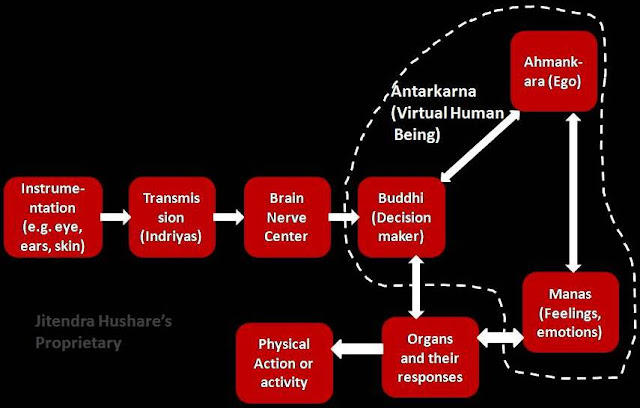Let’s see how our body works. When we see with our eyes, eyes as an instrument will capture the images, in a similar way as a digital camera capture the images. However our eye as a biological camera is far superior, more efficient, less maintenance and long life camera. These nerve signals or biological signals get transmitted via our indriyas or communication channels to a particular part of the brain, we can call it as nerve center. There the image gets imprinted for quick milli-second, immediately our buddhi or decision-making faculty of the brain get invoked to apply some sense or meaning to those images based on its storage or historical data.
Now in above process, if any of the mechanism is not working, then the process is not complete and the image does not make any sense. If the eye is open, but the signal transmitted is not passed or connected to brain nerve center, then seeing does not make any sense. Remember incidence when we are seeing something blankly, our eyes are capturing and transmitting images, but the other part of the brain is active, the part which deals with image processing is not active hence the image or scene does not make any sense. Or if we see some new image which we had not seen previously or our knowledge or information cannot correlate or put the image into perspective, then we get confused or we ignore the image or get lost. But if the image is familiar, our buddhi correlate it with our past experiences or historical data and based on our attachments, our self-identification it gets decided how we interpret that image, either pleasantly, unpleasantly, neutral or ignore it. If our attachment or ahmankara is closely related with the image, based on this, immediately manas (feeling or emotions) come into the picture to form feeling and emotions which drives our physical action mostly unconsciously, without our awareness that why we acted the way we acted. However, if we are not attached or associated with some concepts, ideas, person, places and remain objective, our buddhi will decide the appropriate action which will be a conscious action or consciously it can decide to ignore the image. Similar processing happens with any sense organs including ear, skin, tongue, and nose. And based on our attachments or associations and its threads formed in Ahmankara or Ego, manas (feeling and thoughts) play its game driving our actions and reactions. If we want to come out of the trap of actions and reactions and want to respond, cut down the attachments and associations so that we can able to use buddhi to take our decision consciously and act wisely.
Consider our mind or chitta as lake and our real self as the bottom of the lake. The real self could be our God, our soul, some universal power which drives human body and nature. For simplicity, I will refer it to soul. So, I will be able to see my soul continuously only if the lake of chitta or mind is clean, not muddy or dirty water and also its still/stable and there is no waves playing in it. These waves of chitta we can call as vritti or whirlpool of our internal state. And why do we want to see the soul in this lake of mind or chitta? Because that’s our real nature, as a human being, we are not our body, emotions and so on, we are something more than that, and we are calling that as a soul for simplicity. And it has tremendous power, infinite bliss, unlimited pleasantness and never-ending peace. So to be in touch with that powerful soul, we need to keep this lake clean and clear from our politics, revenge like attitude, practice non-attachment and disassociation and keep on walking on the straight path. And when the waves of emotion, hatred, anger, attachment, lust, greediness and so on emerge in this lake obstructing our view of the soul, we need to watch these waves and consciously subdued them with our willpower. So observation is the key here, to ensure that we should not make the chitta or mind-lake water dirty and watch those waves emerging in the lake. So keep on watching ones chitta or mind, always, 24 hours a day if possible.
So the mantra for happiness as explained above is
· To keep your ahmankara or ego in control by cutting your attachments and associations. This will help you subdued your emotion, anger, feeling, excitement and so on to let buddhi take the conscious and wise decision.
· Keep watching the lake of your chitta/mind to keep the water clean and pure and subdued the waves emerging from it due to ahmankara or ego.
So, there are only two simple rules to remain ever happy. Cut your attachments and keep watching your chitta or mind. And both these concepts need sustained practice, that too for a long time. However, it’s journey worth traveling.
May God bless!


